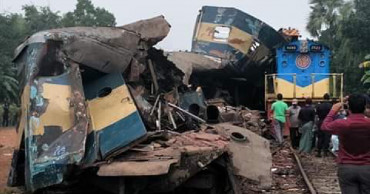Rail Accident
Bangladesh Railway aims to modernise signal system to prevent accidents
Bangladesh Railways has initiated a comprehensive modernisation of its signal system, with the aim to transition entirely to broad gauge tracks by 2050. This initiative is expected to eliminate collisions and enhance overall safety.
In an exclusive interview with UNB, Sardar Shahadat Ali, Director General of Bangladesh Railway, elaborated on the ongoing and future projects.
“We have taken steps to modernise the signal system progressively across all areas. Though the traditional lamp signals are old, they are time-tested; implementing a digital system is a costly affair,” Ali stated.
The Bangladesh Railway DG acknowledged the recent increase in train collisions, attributing them to faulty signal systems. “Until 2030, we will procure locomotives for meter gauge, but after that, we will cease their acquisition. By 2050, the complete transition to broad gauge will prevent such collisions,” he assured.
Discussing the current locomotive scenario, Ali mentioned that the existing broad gauge locomotives sufficiently meet demand. “We plan to bring in 46 more locomotives for broad gauge and 50 for meter gauge. Additionally, the Chattogram-Dohazari project includes the acquisition of 30 more locomotives. However, we are facing a slight shortage of meter gauge locomotives.”
Passengers disembarking from moving trains raises safety concerns
Highlighting the advancements, Ali pointed out, “A tender for the digital signal system from Abdullahpur to Parbatipur has been issued and is under evaluation. The Padma Bridge Rail Link Project will see a digital system operational by June. Areas like Tongi, Joydebpur, Dinajpur, and the eastern and western sides of the Bangabandhu Bridge, will transition to an interlocking system once the ongoing non-interlocking projects are completed.”
Ali also touched upon the challenges of maintaining meter gauge locomotives, which involve transporting them over the Jamuna Bridge to the central locomotive workshop that is facing workforce shortages. “We expect to resolve these issues by 2030 with the arrival of new locomotives,” he noted.
Addressing locomotive defects, the railway DG said, “We have identified some issues with the 3000 series locomotives. Our service engineers are addressing these, and during the warranty period, we aim to rectify all identified problems.”
Regarding the lack of skilled personnel, he said, “It is not possible to immediately hire skilled personnel. First, we need to recruit people and then train them to become skilled and proficient. As employees retire, new ones will be hired and trained to become proficient – this will be a continuous process.”
Burimari Express derails in Pabna, train service between Dhaka and north disrupted
To improve railway services, Ali stated, “We are focusing on timely train departures and arrivals, cleanliness, and food quality. There are no longer ticket black markets, and tickets can be easily purchased online or at stations. Despite high demand, train journeys remain comfortable.”
When asked about expanding train connectivity, he confirmed, “The government is committed to improving train communication across the country. We are increasing the number of trains and coaches as needed, and new locomotives will be purchased to meet future demands.”
1 year ago
Bangladesh Railway faces increasing accidents amid neglected maintenance of aging infrastructure
Despite launching several new development projects aimed at enhancing its services, Bangladesh Railway continues to struggle with the maintenance of old rail lines and bridges, leading to an increase in accidents, including derailments.
Sources from Bangladesh Railway report that approximately 63% of rail accidents are due to deteriorating lines and weak bridges.
Out of the country's 3,400 kilometers of railway lines, only key sections such as the Dhaka-Chattogram, Dhaka-Joydebpur, and Jashore-Abdullahpur lines are double-tracked, while the majority remain single-tracked and in poor condition.
Transport experts have identified numerous systemic issues including frequent station closures, aging rolling stock, deteriorating infrastructure, overcrowding, delays, ticketing problems, and general mismanagement—all contributing to the railway's challenges.
Rail accidents are increasing due to signaling errors, expired coach connections, insufficient supervision of rail lines, risky rail crossings, and lack of passenger facilities.
Overwhelming heat exacerbates health challenges across Dhaka, as children bear the brunt of the impact
According to unofficial information, there are more than 3,400 kilometers of railway lines across the country, of which only 1,000 kilometers are in good condition.
Dr. Hadiuzzaman, a transportation analyst and professor at BUET, criticized the ongoing neglect of essential maintenance in favor of expanding the railway's assets. "There's a tendency to focus on acquiring new locomotives and coaches because it initially costs less than maintaining infrastructure. However, this neglects the crucial upkeep needed for existing rail lines and bridges," he explained.
The neglect is evident in the fact that nearly 2,500 kilometers of rail tracks are considered risky, yet trains continue to operate on them, leading to reduced speeds and efficiency. This was highlighted by recent incidents, including a head-on collision between two trains in Gazipur’s Joydebpur due to signaling errors and multiple signaling mistakes on the Dohazari-Cox's Bazar line in Chattogram.
Govt plans Tk 2000 billion investment in transport and communication for next two fiscals
The traditional signaling method, reliant on manual point adjustments by pointsmen, has been identified as a key risk factor. Station masters' errors in signal provision can lead trains onto the same track, risking collisions. The manual system also increases the likelihood of derailments due to improper point configurations.
Progress on modernizing the signaling system has been hampered by financial constraints and delays in payments to contractors, particularly in major projects like the construction of additional lines from Dhaka to Tongi.
Sardar Shahadat Ali, Director General of Bangladesh Railway, acknowledged the challenges posed by the ongoing projects and the transition to a computer-based interlocking system. He cited staffing shortages and a lack of skilled workers as exacerbating risks but mentioned ongoing efforts to recruit skilled signal staff and strengthen monitoring systems to enhance safety.
Despite these efforts, the newly recruited personnel are still not proficient in the old manual signaling methods, and outsourced pointsmen lack specialized railway training. Regular personnel turnover further complicates the training and adaptation process.
According to the 2022-23 annual report of the Ministry of Railways, 315 passenger trains operate across the country. Among them, 143 trains started their journey in the past 15 years. During this time, 843 kilometers of new railway tracks have been constructed, and 1,391 kilometers of railway lines have been repaired.
Dhk-Khulna, Dhk-Barishal highways turn perilous; 320 die in one yr
Furthermore, buildings have been constructed for 146 new railway stations. Reconstruction of 273 station buildings, construction of 1,037 new bridges, reconstruction of 794 railway bridges, acquisition of 109 locomotives, collection of 658 passenger carriages, relocation of 530 passenger carriages, collection of 516 freight wagons, relocation of 277 freight wagons, and so on, have been done.
Currently, there are 1,788 coaches, 47% of which have gone beyond their service life. The number of operational engines is only 295.
Against a required workforce of 47,600 in the railway, only 24,000 are currently employed.
In the past five years, more than 2,000 accidents have occurred, leaving more than 150 passengers dead, and around 500 injured. In the last four months alone, there have been 160 railway accidents and incidents of sabotage across the country. In these incidents, 18 passengers have died, and 200 have been injured.
1 year ago
Train accident in Odisha: Hotline opened for query about Bangladeshis
A hotline has been opened to provide information or query about Bangladeshis following the horrific train crash in India’s Odisha.Bangladesh Deputy High Commission, Kolkata issued a press release in this regard soon after the accident.It also expressed profound condolences to the families of victims of the tragic Coromandel Express accident, and wished early recovery of the injured.For further query it asked to contact +919038353533 (WhatsApp).
Also read: India train crash kills over 280, injures 900 in country's deadliest rail accident in decades
At least 280 bodies were recovered overnight and into Saturday morning, Sudhanshu Sarangi, director of Odisha's fire department, told The Associated Press.
He said more than 800 injured passengers were taken to various hospitals with many in critical condition.The accident, which happened about 220 kilometers (137 miles) southwest of Kolkata on Friday night, led to a chaotic scene as rescuers climbed atop the wrecked trains to break open doors and windows using cutting torches to free survivors.About 900 people were injured in the accident in Balasore district in the eastern state of Odisha, said P.K. Jena, the state's top administrative official. The cause was under investigation.Read more: India train crash: some Bangladeshis suffered minor injuries, says deputy high commission
2 years ago
India train crash kills over 280, injures 900 in country's deadliest rail accident in decades
Rescuers waded through piles of debris and wreckage to pull out bodies and free people on Saturday (June 3, 2023) after two passenger trains derailed in India, killing more than 280 people. Hundreds of others were trapped inside more than a dozen mangled rail cars overnight in one of the country's deadliest train crashes in decades.
The accident, which happened about 220 kilometers (137 miles) southwest of Kolkata on Friday (June 2, 2023) night, led to a chaotic scene as rescuers climbed atop the wrecked trains to break open doors and windows using cutting torches to free survivors.
About 900 people were injured in the accident in Balasore district in the eastern state of Odisha, said P.K. Jena, the state's top administrative official. The cause was under investigation.
At least 280 bodies were recovered overnight and into Saturday morning, Sudhanshu Sarangi, director of Odisha's fire department, told The Associated Press. He said more than 800 injured passengers were taken to various hospitals with many in critical condition.
Also Read: India train crash death toll rises above 230 with 900 injured as rescuers comb through debris
Rescuers were cutting through the destroyed rail cars to find people who may still be trapped. Sarangi said it was possible that people were stuck underneath but that it was unlikely they would still be alive.
"By 10 p.m. (on Friday) we were able to rescue the survivors. After that it was about picking up dead bodies," he said. "This is very, very tragic. I have never seen anything like this in my career."
Ten to 12 coaches of one train derailed, and debris from some of the mangled coaches fell onto a nearby track, said Amitabh Sharma, a railroad ministry spokesperson. The debris was hit by another passenger train coming from the opposite direction, causing up to three coaches of the second train to also derail, he added.
A third train carrying freight was also involved, the Press Trust of India reported, but there was no immediate confirmation of that from railroad authorities. PTI said some of the derailed passenger coaches hit cars from the freight train.
Read more: India train crash: Few Bangladeshis suffered minor injuries, says deputy high commission
The death toll rose steadily throughout the night as footage showed shattered carriages that had overturned completely. Scores of dead bodies, covered by white sheets, lay on the ground near the train tracks as locals and rescuers raced to help survivors.
Teams of rescuers and police continued sifting through the ruins on Saturday morning as the search operation carried on, amid fears that the death toll is likely to rise further. Scores of people also showed up at a local hospital to donate blood.
Officials said 1,200 rescuers worked with 115 ambulances, 50 buses and 45 mobile health units through the night at the accident site. Saturday was declared as a day of mourning in Odisha as the state's chief minister, Naveen Patnaik, reached the district to meet injured passengers.
Villagers said they rushed to the site to evacuate people after hearing a loud sound created by the train coaches going off the tracks.
Read more: Railway suspends 3 employees over Cumilla train collision, salvage work continues
"The local people really went out on a limb to help us. They not only helped in pulling out people, but retrieved our luggage and got us water," PTI cited Rupam Banerjee, a survivor, as saying.
Passenger Vandana Kaleda said that inside the train during the derailment people were "falling on each other" as her coach shook violently and veered off the tracks.
"As I stepped out of the washroom, suddenly the train tilted. I lost my balance. ... Everything went topsy turvy. People started falling on each other and I was shocked and could not understand what happened. My mind stopped working," she said, adding she felt lucky to survive.
Another survivor who did not give his name said he was sleeping when the impact woke him up. He said he saw other passengers with broken limbs and disfigured faces.
Read more: Train accident in Odisha: Hotline opened for query about Bangladeshis
The derailed Coromandel Express was traveling from Howrah in West Bengal state to Chennai, the capital of southern Tamil Nadu state, PTI said.
Indian Prime Minister Narendra Modi said his thoughts were with the bereaved families.
"May the injured recover soon," tweeted Modi, who said he had spoken to the railway minister and that "all possible assistance" was being offered.
Despite government efforts to improve rail safety, several hundred accidents occur every year on India's railways, the largest train network under one management in the world.
Read more: A look at deadly train crashes in India in recent decades
In August 1995, two trains collided near New Delhi, killing 358 people in one of the worst train accidents in India.
In 2016, a passenger train slid off the tracks between the cities of Indore and Patna, killing 146 people.
Most train accidents are blamed on human error or outdated signaling equipment.
More than 12 million people ride 14,000 trains across India every day, traveling on 64,000 kilometers (40,000 miles) of track.
Read more: India sees huge potential for cooperation with Bangladesh Railway
2 years ago
Feni's death traps: 9 killed in 7 months at unmanned level crossings
Unauthorised level crossings have become a death trap in Feni district where nine people were killed in the past seven months, thanks to the dereliction of the authorities concerned.
Every year, a number of people die in rail accidents in Bangladesh, despite trains being considered one of the safest modes of travel. In 2021, some 147 people lost their lives in 123 railway accidents, according to the official data of Road Safety Foundation released in January, 2022.
Many people have died in train accidents in Bangladesh and a number of probe bodies were formed to look into the accident but the authorities concerned have only fallen on deaf ears.
Read 28-yr-old killed by train in Ctg
The recent Mirsarai train accident on Dhaka-Chattogram rail route is an example of the sheer negligence of the rail authorities.
Twelve tourists including students were killed when a speeding express train rammed into the microbus carrying the tourists at a level crossing in Mirsarai upazila on July 29.
The gateman was suspended after the accident, having been absent from his post at the time of the accident. But unmanned level crossings are not a rarity in Feni.
Read Mirsharai tragedy: Untimely deaths of indomitable youths, their dreams
Local sources said there are 12 unauthorised level crossings on the Dhaka-Chattogram route in Feni and the 23-km route stretching from Sashardi to Muhuriganj has 21 authorised level crossings.
Sub Assistant Engineer of Railway East, Riton Chakma, said people are stretching roads over the rail crossing as per their wish and most of the unapproved level crossings are in Muhuriganj - where there are six unmanned level crossings.
3 years ago
Zaria-Mymensingh rail communication snapped
A passenger train derailed at a rail crossing in Purbadhala on the Zaria-Mymensingh route on Tuesday morning, snapping train communication.
5 years ago
16 dead, over 100 injured in fatal train collision in Brahmanbaria
At least 16 passengers were killed and over 100 others injured in a fatal collision between two trains on Dhaka-Chattogram route in Mandbagh Railway Station in Kasba upazila early Tuesday.
The deadly collision between Dhaka-bound Turna Nishita Express from Chattogram and Chattogram-bound Udayan Express from Sylhet took place around 3am, said Deputy Commissioner Hayat-Ud-Dowllah Khan, who visited the spot right after the crash.
“So far, 16 people have died in the deadly accident, but the figure may go up further,” the DC added.
6 years ago





.jpg)





